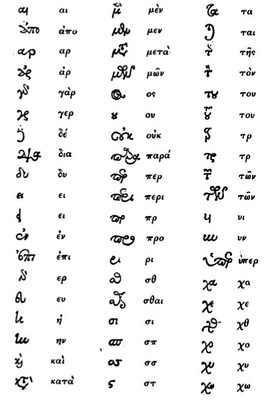Alphabet
| Greek | Latin | ||
|---|---|---|---|
| α | ἄλφα | a | álpha |
| β | βῆτα | b | bē̂ta |
| γ | γάμμα | g | gámma |
| δ | δέλτα | d | délta |
| ε | ἒψιλόν (εἶ) | e | èpsilón (ī̂) |
| (Ϝ) | (δίγαμμα) | (—) | (dígamma) |
| ζ | ζῆτα | z | zē̂ta |
| η | ἦτα | é | ē̂ta |
| θ | θῆτα | th | thē̂ta |
| ι | ἰῶτα | i | íō̂ta |
| κ | κάππα | c | cáppa |
| λ | λάμβδα | l | lámbda |
| μ | μῦ | m | mŷ |
| ν | νῦ | n | nŷ |
| ξ | ξεῖ | x | xī̂ |
| ο | ὂμικρόν | o | òmicrón |
| π | πεῖ | p | pī̂ |
| (ϻ) | (σάν) | (s) | (sán) |
| (ϙ/ϟ) | (κόππα) | (c) | (cóppa) |
| ρ | ῥῶ | r | rhō̂ |
| σ/ς | σῖγμα | s | sîgma |
| τ | ταῦ | t | taû |
| υ | ὖψιλόν (ὑ) | y | ŷpsilón (hy) |
| φ | φεῖ | ph | phī̂ |
| χ | χεῖ | ch | chī̂ |
| ψ | ψεῖ | ps | psī̂ |
| ω | ὦμέγα | ó | ō̂méga |
| (ϡ) | (σαμπί) | (—) | (sampí) |
It should be known that the use of the macron (◌̄) above e & o for η & ω is a contemporary practice. The traditional custom was to translate them as é & ó, which can be problematic if we intend to translate the tones. So, when translating names from Greek, I use the acute mark, but when translating words with tones, I use the macron.
Further, the following digraphs are translated thus:
| Greek | Latin |
|---|---|
| αι | æ |
| αυ | au |
| γγ | ng |
| γκ | nc |
| γξ | nx |
| γχ | nch |
| ει | ī |
| ευ | eu |
| ηυ | ēu |
| οι | œ |
| ου | u |
| υι | ui |
| ωυ | ōu |
When translating names from Greek into Latin, -οc is translated as -us, -ια as -y, -ρος as -er, & -ων as -ó, or, if not a person, -um.
When translating certain sounds into Greek which it naturally doesn’t have, i.e. gi & sh, put τζ & τσ respectively.
Ligatures
There are a number of ligatures, e.g. ϗ for καί, ȣ for ου, & ϛ for στ. More which haven’t digital characters yet:

Pronounciation
See the pronunciation chart on the previous page for how to read the English letters.
| Letter | Sound |
|---|---|
| α | á |
| αυ | áv/áf |
| β | v |
| γ | g |
| γγ, γκ, γξ, γχ | g/ng, c/ng, cs/ngs |
| δ | ð |
| ε, αι | e |
| ευ | ev/ef |
| (Ϝ) | (—) |
| ζ | sð |
| η, ι, ει, οι, υ, υι | í |
| θ | þ |
| κ (ϙ/ϟ) | c |
| λ | l |
| μ | m |
| μπ | b, mb |
| ν | n |
| ντ | d, nd |
| ξ | cs |
| ο, ω | ó |
| ου | ú |
| π | p |
| ρ | r |
| σ/ς (ϻ) | s |
| τ | t |
| τζ | dsð |
| φ | f |
| χ | h |
| ψ | ps |
| (ϡ) | (—) |
The pairs αυ & ευ are pronounced áf & ef when the following letter is unvoiced—e.g θ, τ—but áv & ev when voiced—e.g. β.
Punctuation
| Greek | Latin | Name |
|---|---|---|
| . | . | telī́a |
| : | : | ánō cátō telī́a |
| · | ; | ánō telī́a |
| , | , | cómma |
| ; | ? | erōtēmatikó |
| ! | ! | thaymastikó |
| ’ | ' | apóstrophos |
| ‿ | - | henōticón |
Coptic
The Copts (Ægyptians) adopted the Greek alphabet for writing, but added seven letters:
| Coptic | Translation | Pronounciation |
|---|---|---|
| ϣ | sh | sh |
| ϥ | ph | f |
| ϧ | ch | h |
| ϩ | ch | h |
| ϫ | dj | gi |
| ϭ | tj | tsh |
| ϯ | ti | s |